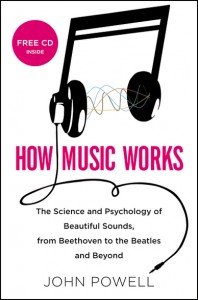What makes a musical note different from any other sound? How can you tell if you have perfect pitch? Why do 10 violins sound only twice as loud as one? Do your Bob Dylan albums sound better on CD or vinyl? John Powell, a scientist and musician, answers these questions and many more in HOW MUSIC WORKS, an intriguing and original guide to acoustics. In a clear, accessible, and engaging voice, Powell fascinates the reader with his delightful descriptions of the science and psychology lurking beneath the surface of music.
I won the book How Music Works by John Powell from Just Another New Blog in January and have finally gotten around to reading it! I was really excited when I won the contest since being an engineer and music fanatic (though believing I had no musical skill whatsoever) I thought this book would be interesting. And it was! My only “negative” thought was that sometimes the chapters seemed to be a bit too long. I often read before bed so I would finish a chapter and just not want to continue on to another if it was going to be as long as the one I had just finished. Or it could just be I picked the book up when I was already too tired to be reading.
The book had a few things I had already known from Physics classes and hearing things here or there, but it also had a lot of fun tidbits in it that I did not already know and I am wowing my friends while we wait for concerts with my musical knowledge! 😉 I was sad to find out that perfect pitch most likely can not be learned after the age of 6. I don’t know why, but that was something I was hoping I could train myself to do. I suppose there is still a chance it can happen though, so I won’t give up hope just yet. However, I learned it is not too late for me to learn to play an instrument. Although, considering I tried this in elementary and middle school with less than stellar results, I’m not sure I’ll be picking up a guitar or anything else any time soon!
Also included with the book was a Free CD with examples from the book such as: How To Get Different Sounds From A Guitar String, Can You Guess What Instrument This Is?, Different Ways to Accompany A Tune, The Horrible Out-Of-Tune Bamboo Whistle and How to Bring Tears To The Eyes Of The Audience among others. (10 tracks in total)
One of the great things about this book is that you don’t really need to read it all at once. You can read a chapter here and there while reading other books (I read 2 or 3 other books in the middle of reading this book – something I hardly ever do because I tend to get stories confused) or just whenever you are looking for random facts about music to impress your friends with!
